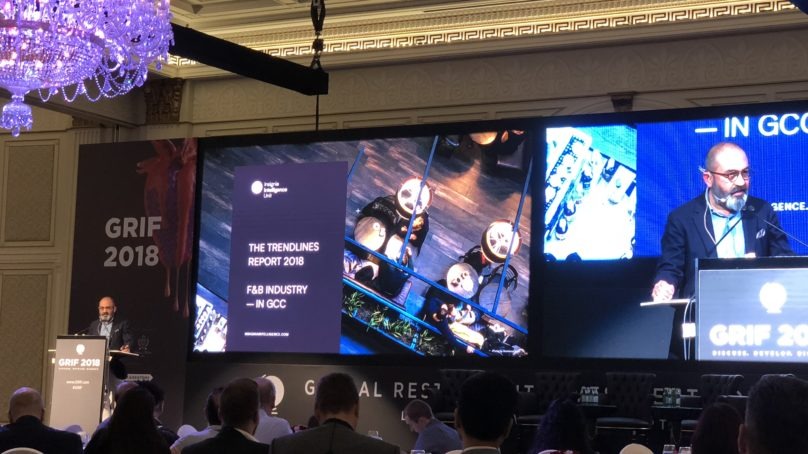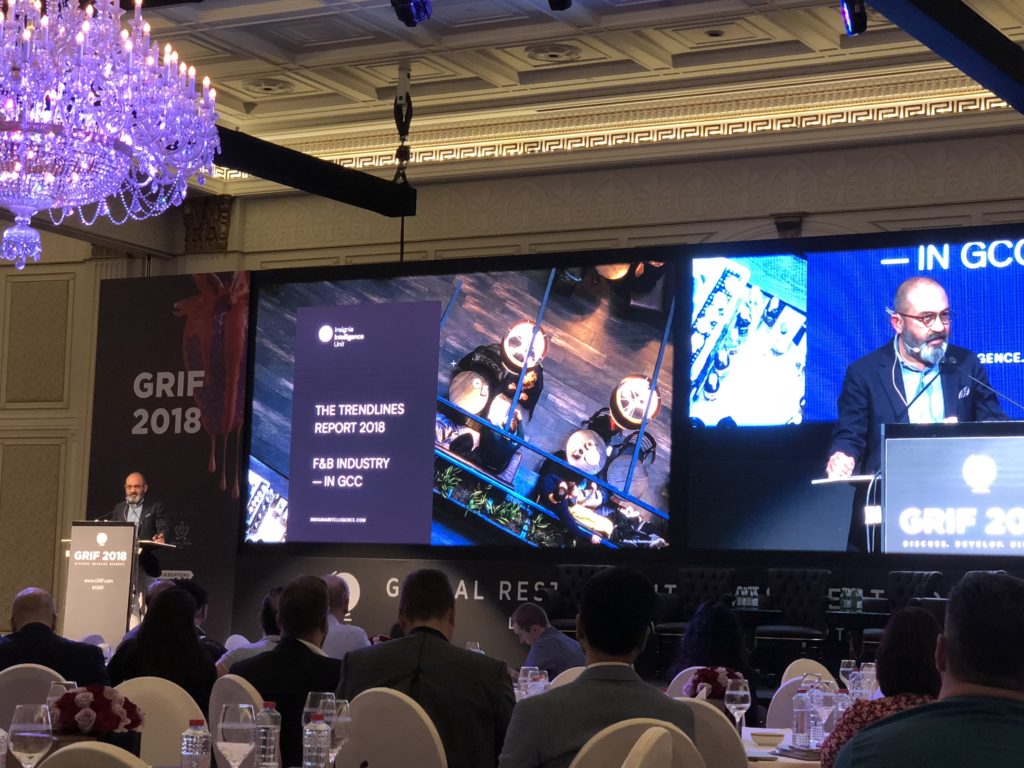

HN provides a first look at key findings from founder and CEO of Insignia Worldwide, Guarav Sinha’s session on the upcoming F&B Trendlines report on the GCC, unveiled at GRIF 2018 at the Palazzo Versace Dubai.
The Insignia Intelligence Unit has produced a very insightful report on market dynamics, supported by data, expert opinion and insightful analysis on challenges and opportunities that will shape the future of the F&B industry in the GCC. Key themes include:
DELIVERING SATISFACTION
- Worldwide, food delivery represents nearly 4% of the total food sold through restaurants and fast-food chain.
- The growth in smartphone usage is set to grow by 30% year on year and, by 2020, QSR’s will earn 10% of sales coming exclusively from smartphones, at which point, the global mobile food ordering is expected to reach USD 38 billion
- Pizza remains the region’s most favorite home delivery category
- In Saudi Arabia, 100% home delivery/take away pizza remained the dominant category in 2016 while non-pizza categories had a negligible presence
CONSCIENTIOUS CONSUMPTION
- Consumers are driving the demand for organic, natural choices for F&B with 77% of respondents citing “eating healthy during the week” or “having become more health-conscious” or “always eating healthy foods”.
- Governments of both UAE and KSA have taken steps that favor healthier dining. By the end of 2018, restaurants in KSA have to provide nutritional information on their menus. At nearly 11%, UAE is the second fastest growing “Vegan” markets between 2015 and 2020 behind only to China.
- Juice and smoothie bars, perceived to be “healthy” saw a growth of 6% in 2016, with chained juice/smoothie bars driving this segment at 15%.
CULINARY MICRO DISTRICTS
- Location and distance is still very important. 63% of our survey respondents said they don’t mind travelling more than 20 minutes to eat out.
- In the UAE, there is a growing desire for closer-to-home convenience, resulting in the creation of “culinary micro districts”. About 10% of diners quoted in the Insignia survey the reason for not dining out was because there was nothing nearby.
THE GROWTH OF MALL DINING
- As more space is proportioned to F&B operators to draw customers into a mall a remarkable 48% of overall value sales was accounted from F&B operations in 2016.
- Malls present unique challenges like higher rents and inflated costs in premium malls that hit the bottom line. The merits of operating in premium mall however include brand exposure and higher footfalls.
- At 52%, Riyadh is the most favorite markets for GCC expansion for F&B businesses, followed by Jeddah and Doha.
FIVE STAR DINING
- The trend of pulling crowds to celebrity chef restaurants is fading as nearly 71% of respondents felt they were overrated.
- At over 13% CAGR for branded hotels, KSA is the hottest destination where growing population and increasingly seeking sophisticated dining options. Among them, Asian Full-Service restaurants was the most dynamic in CAGR growth terms in 2016.
REGIONAL FLAVORS
- GCC represents unique challenges to investors, and F&B operators including expensive setup costs, outdated procedures, and limited local partner choices and excessive visa fees for staff.
- Did you know… 5% of developers own over 87% of the available mall stock of 3.2 million sqm GLA. 15% of retailers operate over 90% of the international brands.
- KSA has recorded the fastest growth in F&B sector at over 8% in the last 4 years. This trend is like to continue over the next 4 years. The Middle East sees an increase in spend, with average annual growth of 7.4% between 2006 and 2016.
EVERY CUSTOMER IS A CRITIC
- Traditional media channels like to PR, print are fading as social media is increasingly becoming a medium to connect and engage with potential diners.
- Instagram has outpaced Facebook in the rate of new user registrations globally. This means restaurateurs now have to create superior imagery experiences that is suited for social media environment. The most popular hashtags related to food on Instagram in 2017 were, #FOODIE, #CLEANEATING, #PALEO etc.,
- 34% of diners between 18 and 24 years use their mobile as a surrogate dining companion.
FUTUROLOGY THE SHAPE OF FOOD TO COME
- The F&B market sector in the GCC states is predicted to continue to grow at 7.1% annually, reaching $196 billion by 2021, (up from $130 billion) according to research company MENA Research Partners.
- Kuwait is the third largest F&B market in the region but set to grow the fastest at 9.6%.
- There is strong favoring towards restaurants that showcased local foods, and use indigenous food.
- There is a growing narrative of consumers drawn towards healthy eating choices, as per Mintel, between 2012 and 2016, there has been a 25% increase in vegetarian claims and a 257% rise in vegan claims in new products.
- KSA is aiming 30 million visitors by 2030 and towards this intends to invest over $40 billion on annual tourism. With a slew hotel investments announced in the country, the dining scene in KSA is set to receive a significant boost.














